
On my nerd shit again. They/them
183 posts
Thatdamhobbit - Sugar And Spice And All Things Dice - Tumblr Blog
the following sleep deprived rambles have every chance of being a total doozy. you have been warned.
okok SO. I just finished listening to the podcast Camlann and I have THOUGHTS bc I always have THOUGHTS when I consume Arthurian retellings and/or adaptations. it's such a unique approach to things so I honestly wasn't expecting the characters to carry on the characterization core through-line that most thoughtful retellings do. I'm in the process of identifying each of the core traits for various characters but those are my academia rambles not my chaotic Tumblr ones lol.
but anyway bc of Camlann's core concept about names drawing them into the associated stories after the cataclysm (I think it was called that. idk started w cat. big bad no bueno thing!!) I assumed pretty early on that this would be more along the lines of this cast, these individuals, resisting and defining themselves as Not Like Them. for an overly simplistic example, if Gwen was adamantly like "no!! I'm nothing like Guinevere!! I'm not a cheater!!" and the whole arc was around her proving that. which is actually a not uncommon (and often well done, despite my tone) approach to Arthurian type stories, namely the reincarnation return type ones. but in that case, the Arthurian characters remain... distant. legendary. a worldbuilding backdrop that don't function with the agency of true characters in the narrative. a shadow cast by the true main characters bc all that matters is being different from them. Arthurian characters are deeply flawed, it's a tragedy in many ways, and so people gravitate to "but I would be better than them!!" and it can be a good story but it doesn't really encapsulate the beauty of the flawed that I personally love about arthuriana.
now, despite that ramble, that is NOT what Camlann did, despite what I expected! that would be the easy way out! instead I was emotional over Gawain bc, since he's the Arthurian character I've researched the most, I'm keenly aware of the character's core characteristics that transcend retellings. and Gawain was still so Gawain. impulsive, held up as the flawed one in the cast, but ultimately so full of love and loyalty and agjsjfjsb he's my baby boy in academia. the Merlin character keeping secrets and pulling the strings for a convoluted mixture of protection for loved ones and protection for himself? checks out. Guinevere fervently wishing she didn't have to behave queenly and could just be wild and powerful in her own right?? YES. I had thoughts on the others too but! sleep deprivation brain go soupy!!
anyway, all this fascination w core traits, but I ultimately would like to dive into arthur. he's at the center of the narrative in so many ways. there's so much more to analyze for him tho! anyway I'm especially intrigued by Arthur's ability to be both hero and villain depending on the narrative while still being so distinctly ARTHUR, not just *insert king character here*. he's the archetypal hero, and I do like that myself, but that's why good villainous arthurs are so fascinating to me. think King Arthur from Legendborn and Bloodmarked by Tracy Deonn. that series is what got me thinking about what could be his universal trait. and even after just a bit of Camlann's Arthur, I really do think it's innately tied to the portrayal of Camelot in the narrative. and Arthur is always trying to defend it. if it's BBC Merlin's Camelot, it's flawed but ultimately good and worth trying to save. its Arthur reflects that. if it's legendborn's Camelot where it is an exclusionary system representative of societal oppression and control, its Arthur reflects that. and in Camlann? Camelot is a bunch of dudes using the power of their names to live out a game of thrones aesthetic, and is functionally a power fantasy constructed to make people feel falsely safe in a dire circumstance. so, Camlann Arthur is fundamentally someone who will go to the ends of the earth to defend his Camelot.
but idk I need more content to know for suresies so anyway pls go listen to it bc I rlly want a season 2.
anyway good night.
The waffle incident took place on the 17 of June. The day Captain Ghafa should have docked for two weeks. Alas her ship was caught in a storm so her crew had to dock at a Ravkan port.
Kaz Brekker was reported had waiting at 5th harbour for three hours before he dissappeared and burst into Wylan Van Eck's estate where Wylan Van Eck, Jesper Fahey and a recently returned Nina Zenik.
They had been eating waffles waiting for Captain Ghafa and Kaz Brekker so when he picked the lock and kicked down a door to yell "INEJ ISNT THERE!" in the voice of a panicked teenager who's crush just texted them "Wyd?" Nina Zenik snorted waffles out her nose. Not much is known apart from that but we do know that a waffle ended up on the ceiling one on Mr Brekker's face and several in the garden.
The group was later heard arguing with snippets such as "No Jesper you CANNOT eat the waffle that is stuck the the ceiling." "Nina Zenik is that a strawberry in your hair?" "Wy I regret to say that WAFFLE FIGHT"
Several stadwatch were called to the scene but when the arrived the place was spotless and nobody was home.
It is still unsolved.
Dai: In your opinion, what is the height of stupidity?
Perry (turning to Gwaine): How tall are you?
SO GOOD
Your Tumblr username decides your profession. How is your first day at work?
A List of Things, in No Particular Order, that I Would Really Want To See in a Silmarillion Film/TV Show
Luthien. Just Luthien. Pretty elven princess being Really Fucking Powerful? Yes please! (Bonus points if they get Liv Tyler to play her)
The fight between Fingolfin and Morgoth. I recently reread this bit and holy crap it sounds so cinematic.
Haleth! Really obscure and under appreciated but I love her so much.
Maedhros during the Dagor Bragollach. I forget the exact wording but he sounds terrifying and awesome.
Honestly Maedhros in general. His whole arc is so rife with angst and story potential. Like maybe a tale of the Silm from Maedhros’s perspective.
I feel like Turin Turambar would make a really good monster-of-the-week-but-also-with-plot kinda TV show. Like a set up ep with him coming to Doriath, then a season in Doriath ending with the Saeros debacle, then a season with the outlaws, then a season in Nargothrond, then a season in Brethil with a dramatic final few eps against Glaurung. Lots of little problems (hence monster-of-the-week) carrying the overarching plot.
I feel like Elrond would be another great framing device for the events of the Silm because his ancestry touches nearly every part of it, esp if you include the kidnap fam.
(Ok, so I picture this post-Doriath, but pre-Sirion)
How has everything been turned against us?
How did suffering become so endless?
How am I to reunite with my estranged?
Do I need to change?
I’m surrounded by the souls of those I’ve lost. (figuratively rather than literally)
I’m the only one whose line I haven’t crossed.
What if the greatest threat we’ll find across the sea (!)
Is me. (Ok not as plausible bc Morgoth but still)
What if I’m the monster, what if I’m in the wrong?
What if I’m the problem, that’s been hiding all along?
What if I’m the one who killed you, every time I caved to guilt?
What if I’ve been far too kind to foes, but a monster to ourselves?
What if I’m the monster?
(Now the fun bit)
Was my father struck with guilt when he killed, was he up in the middle of the night,
Or did he end those elves just to win ourselves some boats so that we could take our flight?
When my brothers stormed Doriath to fulfil the oath, were they going insane,
Or did they truly believe that we could be free, wanted to fight to spare us all more pain?
When the gods close their gates and turn us away, are they scared that they’re doing something wrong?
Or do they keep us in check, so we must respect them, and now no-one dares to piss them off?
Does a prince attack an elven city to reclaim his birthright ‘cause he is vile,
Or does he throw away his remorse and save his family with guile?
If I became the monster, and threw that guilt away, would that make us stronger would it keep our foes at bay?
If I became the monster, to everyone but us, and made sure we reclaimed the gems, who would care if we’re unjust?
If I became the
(Monster)
Oh ruthlessness is mercy upon ourselves
(Monster)
And deep down I know this well, I lost my best friend (fingon), I lost my brothers, my father, so many elves gone, this can’t go on, I must keep those who I have left still here with me, so if we must fight through
Dangerous foes and defeat them we’ll go where the Dark Lord won’t reach us and if I’ve gotta storm the Havens, kill the princess, get the gem, fulfil the Oath?
Then I’ll become the monster, I will deal the blow,
And I’ll become the monster like nothing ever known,
So what if I’m the monster lurking deep below, I must become the monster, and then we can go home.
(Monster)
My brothers
(Monster)
My father
(Monster)
Oh ruthlessness is mercy upon ourselves
(Monster)
I’ll become the monster
🎺(ominous brass)🎺
‘Monster’ from EPIC: the Musical x Maedhros Feanorion.
You see the vision.
‘Monster’ from EPIC: the Musical x Maedhros Feanorion.
You see the vision.

modern sons of fëanor ?? #kinslayingit
A Refutation of Claims Made by Professor Basil Dyer in the Minas Tirith Review
for @silmarillionepistolary | M | ao3
It has come to my attention that The Minas Tirith Review has recently published an essay by one Professor Basil Dyer detailing and reinterpreting letters exchanged between Fingon, son of Fingolfin, and Maedhros, son of Fëanor, in light of recent translations and publications of long-censored exchanges. In his composition, Dyer claims the letters show evidence of long-established homoaffective relationship between the two, beginning shortly after Fingon’s arrival and in Beleriand, and continuing until his death.
This turn in the discourse is troubling, both because of the undue and perverse attention which it may attract to this noble publication and for the aspersions which it may cast upon the already well-sullied reputation of the historiographer. Perhaps if there was any academic merit behind them such faults may be forgiven, but they consist of nothing besides applying an all-too-modern understandings of customs (and the ever-loosening morality of the age of Man!) onto the long-gone age of the Eldar.
That said, I shall begin by laying out the terms of the engagement. Let us assume, for the sake of simplicity and brevity both, that there is no doubt on the matter of authenticity of the letters exchanged between our two principal figures during the Long Peace. Even the most recently recovered—and most hotly contested—of these letters, dated F.A. 345, referred to in the previous publication by the first lines (“Concerning the matter of honey…”) and sometimes abbreviated as the “honey missive” (alternately, in particularly tasteless publications, the “honey-thigh letter”) in such discourses, shall be accepted into our metaphorical evidence box (though indeed any reader familiar with my previous publications might be predisposed to hold its veracity in some doubt). I shall also reference the K. M. Singer translation of all available letters as the most widely-accepted and aspire to make no reference to the probable inaccuracies in Singer’s understanding of Quenya terms of endearment and vocabulary regarding parts of the body.
It may be wise to note before we begin that ladies of a delicate composition and children may find frank discussions of homosexual activity unnerving and inflaming. I would urge readers to exercise caution.
And so, our terms of engagement well-laid, I shall begin by establishing the reasons any romantic or sexual entanglement between Fingon of the House of Fingolfin and Maedhros of the House of Feanor is entirely impossible, then move on to a sensible and scholarly interpretation of the letters.
First, I draw the attention of noble reader first to the matter of cousin-marriage among the Eldar. While laws prohibiting cousin-marriage may appear novel and controversial to the modern Gondorian—indeed even a generation ago such unions were common among Men—the Eldar have once again proved perceptive beyond the ancient days during which they lived, and our betters in matters of morality and purity.
I will not bore the reader with a recounting of the Fall of Gondolin, but work only to draw the reader’s attention to the doomed romantic entanglement at its center. Maeglin, the nephew of the King, coming out of savage darkness, saw Idril, the king’s daughter, and loved her. Given the depth of infatuation he purportedly developed it seems likely to the modern sociologist that for some time she encouraged this attention. Of course, as a highborn Noldo raised among a peoples of impeccable moral discretion, she had known for the beginning that such an affair could not bear any fruit. Such knowledge could not be expected from Maeglin, and many attribute his eventual decline and betrayal of the city to a broken and aching heart.
That such an understanding was so plain to her and yet not to him may seem strange. Were they not both elves, living in the first of age of Arda, and nearly of the same blood? The answer to such a query might come from the relative moral tightness of Noldor society. Recall that Maeglin was no native Gondolian, but a son of the house of Eöl, and so of mixed Sindar and Avar heritage. All recording of first-cousin marriages among Elven Kin, as few as they are, come from lowborn elves among these two tribes. Recall that neither grey-elven nor dark-elven tribes, as their names suggest, had ever journeyed to the sacred light of the Blessed Isles, nor received council from the Valar. Their traditions and customs, then, may seen as more akin to those of Men than elves, lacking the moral rigor of their light-elf counterparts.
Though I do not claim to liken homosexual acts to the sacred institution of marriage, one must admit that the act of bodily union is shared among the two, and so may be held in common as forbidden under the laws of the Noldor.
With those facts in mind we must return to the matter of Fingon of Hithlum and Maedhros of Himring, famously first-cousins through the lines of their fathers. There is no question that that both were elves full-grown upon their departure to Middle-Earth, that according to all sources Fingon was a particularly devout follower of Aran Einior, the lord of air and great judge. Though the latter acts of Maedhros indicate a rather tenuous connection to the sacred laws of his people, Fingon’s devotion did not waver in his lifetime. Raised in such a morally upright culture, neither of them likely would have been able to conceive of engaging in any unholy union. Indeed, such a thought must have been so far from their minds as to allow a certain looseness of the tongue and purity of platonic intimacy, as evidenced by some of the exchanges I address.
Next we must discuss homosexuality among the Eldar. For years the historical establishment has maintained that no homosexual activity had ever existed among elven-folk; indeed, it is an affliction that appears to trouble only the modern Man. That school of thought has been challenged recently, with very little justice. Basil Dyer and Feya Patrice, two of the most infamous names subscribing to this school of thought, point to articles of elven art which they claim contain themes of same-sex entanglements. Most notable among these are Fragment #221 by Daeron the Bard, which appears addressed to a male lover, surviving recreations of Lalwendë and a Friend in Bed by an unknown artist, and a series of oil lamps recovered from Eregion which seem to depict various sexual acts between elves. This evidence is scant, and spurious at best. More detailed refutations of the first two—clearly expressions of deep platonic affection or affectation of a different character—may be found in my earlier bodies of work, while the last is plain done in the spirit of parody.
Indeed writings by earlier historians indicate that no desire could occur between elves without procreative desire, plainly rendering same-sex unions impossible. Relationships which modern historians sometimes interpret as homosexual are indeed better described with the elven understanding of melotorni and meletheldi, translated as chosen love-brothers and love-sisters respectively. That some form of platonic physical intimacy might have existed within these bonds is inarguable, but plainly it did not rise to the unholy stirrings of the flesh.
All of the surviving letters available to us are those addressed from Maedhros to Fingon. Though these do not use the term meletorni directly, it is plain to see that many terms of brotherly affection to enter their forms of address. The opening of letter #5, addressed F. A. 302, has been much maligned, for to a modern reader it appears rather excessive in its affection. “Most beloved of cousins,” Maedhros writes, “how I miss thy kisses, and the weight of thy body atop mine, and the sweet softness of thy ear-tips beneath my mouth” —and on, in such a fashion, for a time. A modern reader may see conventions of a love-letter within these words. A historian intimately familiar with the details of the correspondence of the eldest son of Feanor would argue otherwise. Indeed, Maedhros appears often expressive of his affection.
Of his surviving letters only remains which is addressed to Maglor the Bard, the eldest of his brothers and his second in command, mailed in F. A. 456, pleads with him to “take heart, and hold close my kisses.” Similarly, journals kept by contemporaries note nothing unusual in exchanges of kisses between friends, brothers, cousins, and so forth. A later elven play following the events of the Fall of Nargothrond features a kiss between Finrod and Orodreth in parting; similarly, artistic depictions of Finwë’s death often show his son kissing his face and his lips. What may seem unthinkable to the modern Gondorian was indeed quite commonplace among the Noldor.
Which brings us to another turn of phrase in letter #5, which has gained some level of infamy among those determined to read perversion into the intimacy of their friendship. Lines 304-314 read as follows: “I have received thy handkerchief, with the sweet scent of thy sweat and thy perfume, and the imprints of thy lip-paint kisses. Know that I have sewn it now against the heart of my sleep-robes, so each night I might feel thee upon my breast, and that a hundred times now I have kissed the same cloth as thou hast.”
I would not blame the modern man whose mind conjures a young woman pressing lipstick-kissed onto a postcard for her beloved, but in cultural context the meaning of these words changes. While it may appear rather odd in our time, lip-paint was common for men and women both among the Noldor. Being, for all their nobility, at times a vain people, the Noldor historically likened physical beauty to battle-prowess. The sending of lipstick-prints can be read as a show of force and physical ability between two young men, somewhat akin to bragging. The answering kisses, then, signal not a desire for intimacy but answering show of strength and of power.
I may go on for some time to discuss each mention on kisses in the surviving letters, I would assume any discerning reader would be able to understand them by now as brotherly affection. And so, without further delay, I will move on to address the honey missive.
First, let us examine lines 2-13 of the honey missive, the most hotly debated in meaning:
“Concerning the matter of honey; while I should be glad to sample any taste of the spring of Hithlum thou shouldst be willing to share with me, we have no great need of in trade. The wiry clover and harebell of Himring make for surprisingly subtle yet fragrant honey, thick and amber-gold. But indeed so taken with thee I am that even thoughts of trade I return to thee, and of honey; how I sit and think of thee bare before me—of how I might take such sweetness and spread it upon thy handsome thighs, to work clean with my mouth. I would be much obliged if thou wert to write to me of how thou wouldst stir beneath me, and call my name—indeed nothing now could make me happier.”
In interpreting this passage, we must remember the positions of the Noldor as craftsmen and admirers of art. Despite being remembered now primarily as a warlord, Maedhros was born the son of a gem-smith and a sculptor, and was raised in a society which placed much appreciation on both masculine and feminine beauty. That in his time Fingon was considered beautiful is undoubtedly true. The rest, while resembling a sexual act to some readers, is plainly ridiculous, meant in all likelihood as a joking exaggeration. It is common among young men even in our time to joke crudely with each other; if we had Fingon’s letter of response I am certain we would see a laughing refusal.
Having examined the scope of the evidence before us, I believe any reasonable reader would be forced to yield to the rightness of my position, and to admit there is nothing at all to the claims of those like Dyer, who seek to introduce perversion into the annals of history. We must then examine the motivations behind these claims, and wonder if Dyer and his ilk might not mean to work backwards, seeking justify their modern-day inclinations by creating precedent where is none. It is said, after all, that Basil Dyer has not cohabitated with his wife since the first two weeks of their thirty-year marriage.
Thingol: *Offended spluttering*
Maglor: In your opinion, what’s the height of stupidity? Maedhros: *turning to Thingol* How tall are you?
“Average apocalypse survivor misses 3 hints per day” factoid is a statistical error. Morgan Jones, who is supremely oblivious and should just kiss Gwen already, is a statistical outlier and should not have been counted.
Tell him you’re going to steal his watch
WHAT'S THE EASIEST WAY TO STEAL A MANS WALLET??
*meanwhile, in the Underworld* Polites: Eurylochus, back so soon? And...there's the rest of your crew. And by the gods, what happened to you? Eurylochus, who is sick of thematically-significant reprises: >:(

That's it. That's basically what the song is about.
Just accidentally brought up politics with my parents. Why do I do this to myself.
@conanssummerchild you have infected my dash. I understand none of this, but I get the feeling you’ll enjoy it.
I walked past these socks at Walmart last week, thinking I'd shared them before, but I double-checked, and--nope! New designs!


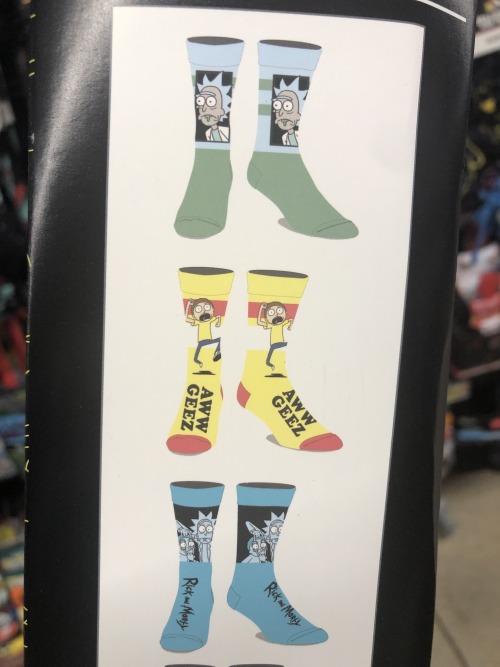
I went to a craft fair that weekend and found Rick and Morty Croc charms. Never leave the house without Rick flipping you off.

Today, I thought I'd visit a mall about 40 minutes away that I haven't visited in years, thinking I might find some new merchandise. I drove all the way up there, and...nope. All the retail stores are gone. Apparently, the owners are redesigning the property as a restaurant/entertainment space.
Fuck!
Another mall sits nearby, but I rarely go there because they don't carry much Rick and Morty merchandise, either. They don't even have a Spencer's! But it's been a while, so I decided to give it a shot.
No luck. The only thing I liked is that their Hot Topic has the old brick entrance that I remember from my youth. I wish it still had the creepy sign, but I guess Hot Topic is less "goth" and more "nerd" these days.

I'd given up hope when I spotted a bootleg streetwear store. The one in a mall that I usually visit closed for some reason, so I thought I'd give it a shot. And boy, did it deliver!
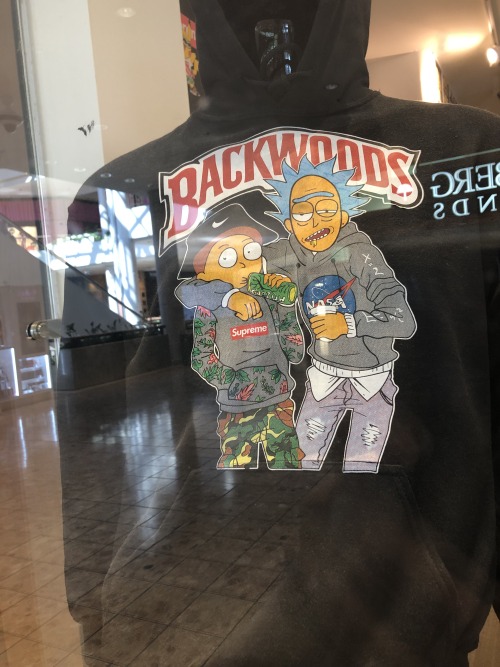
I've posted some of these designs before, but I haven't done a streetwear roundup before, so...eh, fuck it.
These are definitely new:
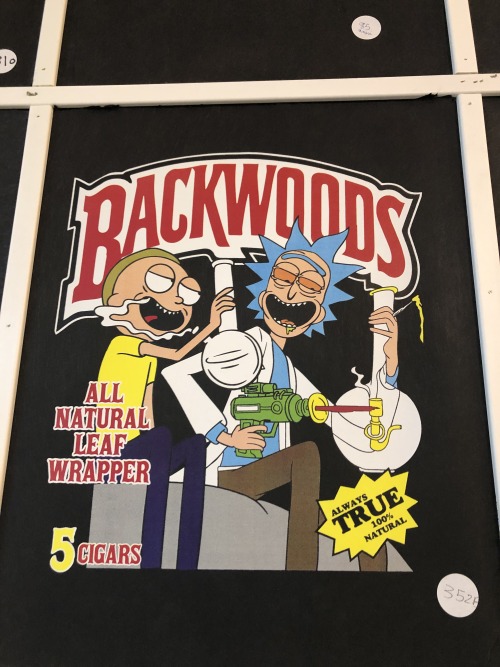

This makes me extremely uncomfortable.
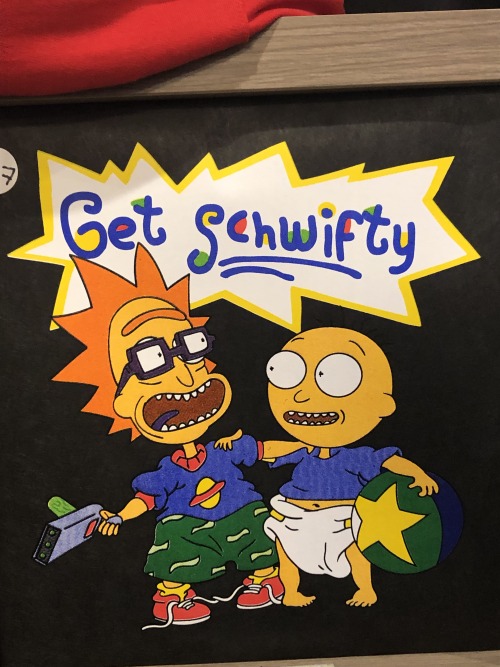
When the employee saw me taking pictures, he said "Do you like Rick and Morty?" I said "Yeah, it's a great show!" He showed me this design, which I've never seen with this text before:

I assume that the bros who wear this shirt are aware that Rick was jealous and wanted to marry Bird Person. They love homoerotic angst!
Anyway, let's all get high with Bart Simpson.
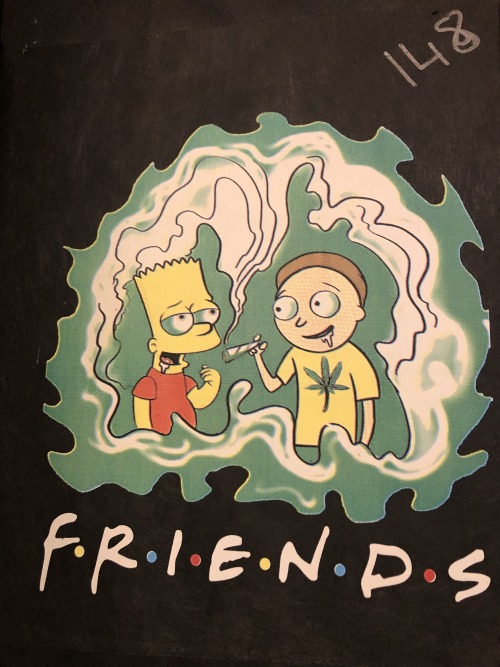

Or just get trashed in general. I guess Rick's hair DOES resemble a pot leaf...

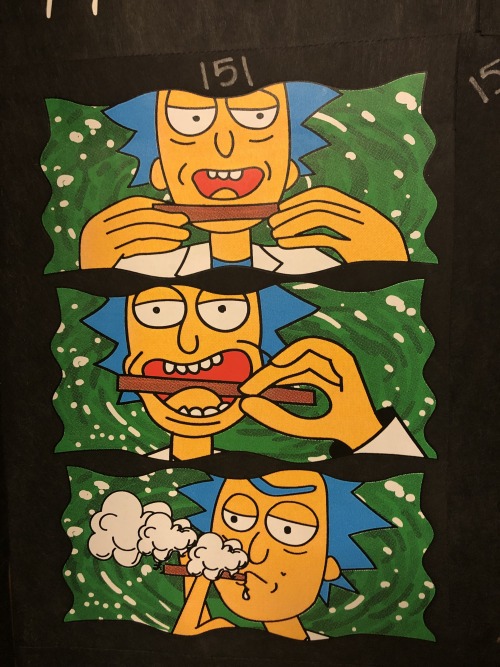
Crossovers galore!
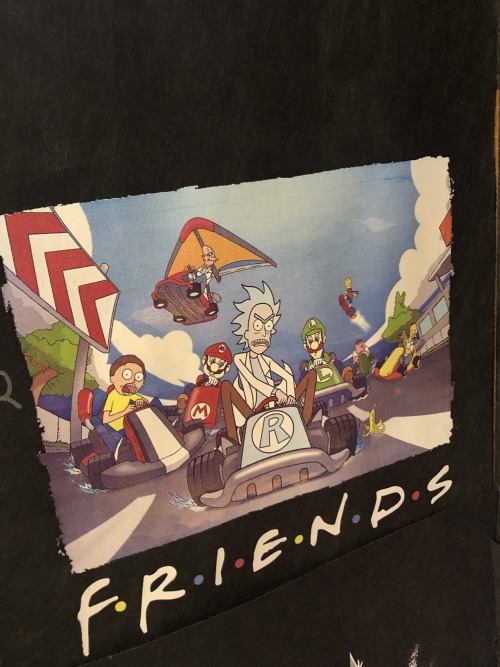

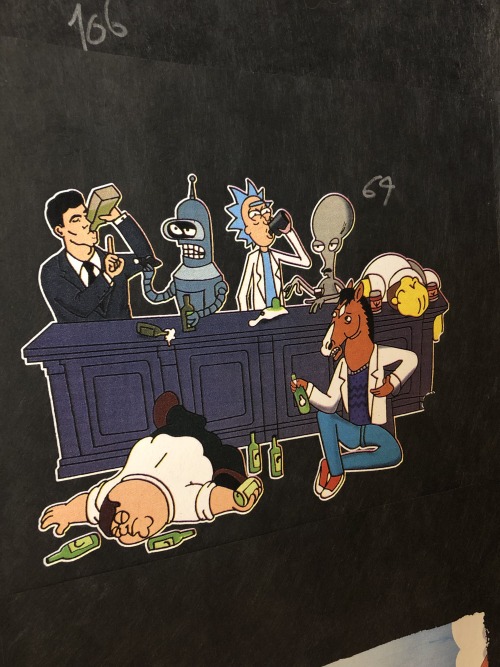
"Gangster" edits will never stop being funny.





A few miscellaneous shirts, including the classic--now with a new Dragon Ball Z-inspired logo!
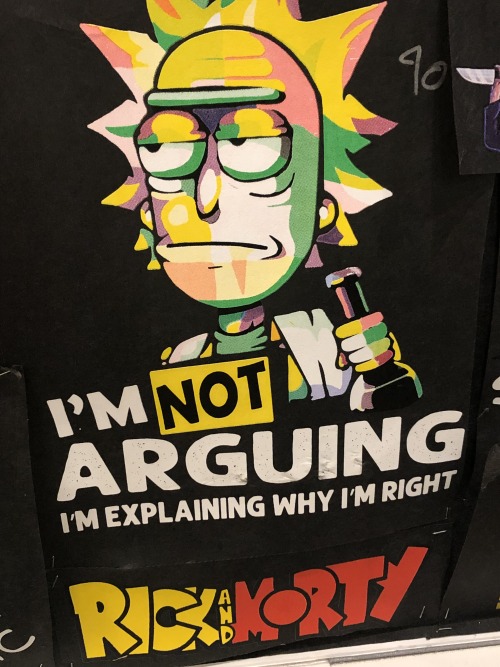


Real Rick and Morty fans have a different "I'm not arguing, I'm explaining why I'm right" shirt for every day of the week, plus a few extras.
After that, I checked out the bootleg poster store next door and found a new illustration. I'm not sure if it's AI or not.

I've posted this design before, but I see it in EVERY bootleg sign store, and it cracks me up every time. It's just perfect.
"Come on, Morty! Let's drive around while we get blasted!"

Rick's wearing a goat necklace, so you know he's the GOAT. Certified loverboy? Certified portal traveler.

who else up hurkleing their durkleing
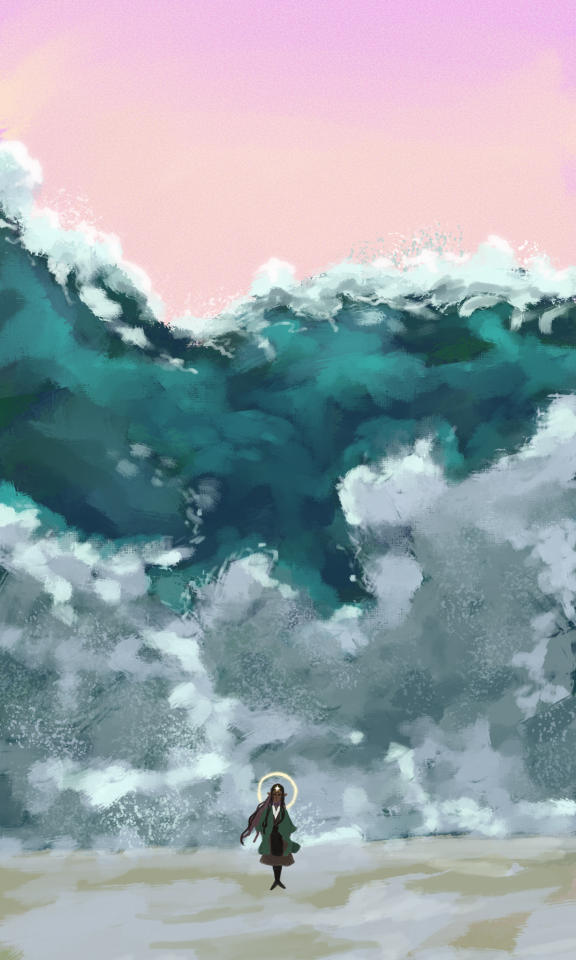
Elrond, Who Calls the River
Oh don’t mind me over here just thinking about how my oc will inevitably lose the most important people in her life and will be left behind and have to keep going (I am entirely to blame (I wrote her storyline))
Elvish art genre that definitely exists in Middle-Earth: the captivity of Elrond and Elros (mostly just Elrond, especially after Elros dies)
The paintings– done mostly, but not always, by Sindarin and anti-Feanorian Noldor artists– are usually studies in contrast– Elrond as the bright, innocent child dressed in white; often portrayed as a small, frightened elfling, frozen at the moment he was taken from Sirion. Sometimes he is shown bravely resisting the cruelty of the Feanorians, other times he mourns for Sirion, or bows and prays to the gods for deliverance. Sometimes, he's given wings, both to stress his connection with Luthien and Elwing and to make him look more angelic and pure in comparison to the fallen Feanorians.
Maedhros and Maglor are the dark monsters the oath made them, with teeth, and claws, and harsh armor. Some of the more daring artists just portray Maedhros as an actual orc. While few of the paintings actually show the Feanorians' crimes, they're often portrayed with blood on their hands or swords, or simply surrounded by fire and destruction. They often demand, or threaten in the pictures, towering over Elrond and casting long shadows on him.
There's a few different sub-genres of these paintings. The ones that explicitly compare Elrond's situation to Luthien's kidnapping by Celegorm. The ones that feature a grateful Elrond being saved from the horrible Feanorians by whoever the artist is looking to valorize– Gil-Galad, Galadriel, Oropher, Eonwe, etc. The ones that show Elrond, locked in a dark cell, staring longingly out at Gil-Estel rising in the night sky. Some of the strangest are the ones that draw connections between the Silmarils being kept in Morgoth's crown and the twins– often with Maedhros playing the role of Morgoth.
Elrond hates almost all of these paintings. He feels like they take away his ability to define his past the way he wants to– to tell his own story. Most of them are grossly inaccurate, but most people don't know that, and dredging up all those really painful memories to try and correct people's assumption is hard. Sometimes, even when he does, people won't listen. Some of the paintings also seem... weirdly gleeful about the idea that Elrond suffered because of the Feanorians? Like they're trying to martyr him even though he's alive, and doesn't want to be martyred. It all makes him really, really uncomfortable.
There is one exception. It's not a very traditional example of captivity paintings. Elrond is at the center of the frame, shown not as a small child but as a young adult. Maglor and Maedhros are mostly unseen in the background, each with a bloody hand on one of Elrond's shoulders. Unlike the other paintings, instead of looking off into the distance or staring demurely at the ground, Elrond is looking straight out at the viewer His expression is hard to place. Anger? Acceptance? Defiance? Pity? Accusation? It's a very odd picture that unsettles almost everyone that look at it.
Elrond insists on hanging it in Rivendell.

